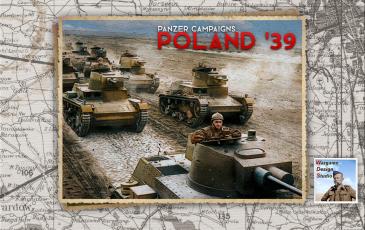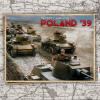0908_01_Gdynia - Allied AI - PzC 31 Poland '39

b59375da7db50f7a9280.jpg) 0 - 0 - 0
0 - 0 - 0
4f09d1569063283d124d.jpg)
| Rating: | 0 (0) |
| Games Played: | 0 |
| SM: | 3 |
| Turns: | 45 |
| Type: | Stock |
| First Side: | Axis (Poland-39) |
| Second Side: | Allies (Poland-39) |
Date: September 8th, 1939 - Size: Small - Location: Gdynia
Intended for play as Axis Human vs Allied AI or Head to Head
Scenario Briefing: Though the occupation of the Polish Corridor was of principal importance to German war planners, the seizure of the Polish port city of Gdynia, the reason for the Corridor's existence, was an afterthought. Pushing across the Polish Corridor on September 1-4th, the Panzers and front line infantry divisions of the German 4th Army bypassed Gdynia and instead plunged into the heart of Poland. Poland's only Baltic port was left to an odd collection of Landwehr, border guards, and miscellaneous units formed from Danzig paramilitary and police organizations.
After 1st Danzig Infantry Regiment's advance against the Gdynia defenses was repulsed on September 1st, Danzig commander Georg-Friedrich Eberhardt focused his attention on Westerplatte and waited on reinforcements from the west. Meanwhile, Carl von Tiedemann's 207th Infantry Division crossed the Polish border and seized Koscierzyna on September 2nd. From there, Von Tiedemann's Landwehr proceeded northeast toward Gdynia, encountering little resistance and linking up with Eberhardt's command on the 4th. As they tightened their grip on Gdynia, Von Tiedemann and Eberhardt were placed under an improvised corps commanded by Leonhard Kaupisch of Border Guard Sector Command 1. Though he possessed a huge numerical advantage, Kaupisch proceeded cautiously. Rather than employ his second rate troops in potentially costly frontal assaults against prepared positions, Kaupisch opted for a methodical battle in which would leverage his superior numbers to outflank and overwhelm isolated Polish positions.
Having maneuvered to contact on September 6-7th, Kaupisch ordered an attack on September 8th. 322nd Infantry Regiment, supported by two border battalions and 207th Division's reconnaissance group, would make the main attack against the Polish outpost at Wejherowo. Meanwhile, 368th Infantry Regiment would demonstrate against the Kartuzy ON Battalion near Kielno while III/IR 89 (on loan from the 12th Infantry Division), attempted to exploit a gap in the Polish lines. To the north, elements of the 42nd Border Regiment would advance on Puck to cut Gdynia off from the Hel defenses.
The odds against the Polish defenders were very long. Colonel Stefan Dabek, commander of the landward defense, had at his disposal just eleven infantry battalions, less than half of the German force. More seriously, the Gdynia garrison, short on all manner of heavy infantry weapons and supported by just one artillery battalion, was vastly outgunned. Despite their numerical and material deficiencies, the defenders of Gdynia possessed no shortage of spirit and were prepared to defend Poland's port to the last. The army was supported by Gdynia's citizenry. The shipyard welders crafted a set of improvised armored trains and thousands of unrecruited, unemployed factory workers volunteered for military service, hundreds of whom would go into battle armed with nothing more than antique French rifles and scythes.
Confronted with such overwhelming numbers and without hope of reinforcement, no measure of skill or elan could save Gdynia. The mission of the defenders was therefore not to hold the city indefinitely, but instead to die in place and make the invaders pay a heavy price for their prize.
Recommended Rules: (Default)
Alternative Assault Resolution, Artillery Set Up, Recon Spotting, Virtual Supply Trucks, Optional Surrender, Low Visibility Air Effects, Quality Fatigue Modifier, Counter Battery Fire, Night Fatigue, Programmed Weather.
Additionally, Delayed Disruption Reporting will provide a more challenging experience for the attacking player.
Design Notes:
1. This version of the scenario covers the fighting at Gdynia from September 8th-12th and ends when Dabek chose to abandon the city and retreat to Kepa Oksywie.
2. This scenario's victory conditions are steep and strongly emphasize force destruction. The German player is unlikely to win if the Polish-German casualty ratio is less than 2:1.
3. Gruppe Eberhardt played in a minimal role in the battle and most of its elements will remain fixed for much of the scenario.
Intended for play as Axis Human vs Allied AI or Head to Head
Scenario Briefing: Though the occupation of the Polish Corridor was of principal importance to German war planners, the seizure of the Polish port city of Gdynia, the reason for the Corridor's existence, was an afterthought. Pushing across the Polish Corridor on September 1-4th, the Panzers and front line infantry divisions of the German 4th Army bypassed Gdynia and instead plunged into the heart of Poland. Poland's only Baltic port was left to an odd collection of Landwehr, border guards, and miscellaneous units formed from Danzig paramilitary and police organizations.
After 1st Danzig Infantry Regiment's advance against the Gdynia defenses was repulsed on September 1st, Danzig commander Georg-Friedrich Eberhardt focused his attention on Westerplatte and waited on reinforcements from the west. Meanwhile, Carl von Tiedemann's 207th Infantry Division crossed the Polish border and seized Koscierzyna on September 2nd. From there, Von Tiedemann's Landwehr proceeded northeast toward Gdynia, encountering little resistance and linking up with Eberhardt's command on the 4th. As they tightened their grip on Gdynia, Von Tiedemann and Eberhardt were placed under an improvised corps commanded by Leonhard Kaupisch of Border Guard Sector Command 1. Though he possessed a huge numerical advantage, Kaupisch proceeded cautiously. Rather than employ his second rate troops in potentially costly frontal assaults against prepared positions, Kaupisch opted for a methodical battle in which would leverage his superior numbers to outflank and overwhelm isolated Polish positions.
Having maneuvered to contact on September 6-7th, Kaupisch ordered an attack on September 8th. 322nd Infantry Regiment, supported by two border battalions and 207th Division's reconnaissance group, would make the main attack against the Polish outpost at Wejherowo. Meanwhile, 368th Infantry Regiment would demonstrate against the Kartuzy ON Battalion near Kielno while III/IR 89 (on loan from the 12th Infantry Division), attempted to exploit a gap in the Polish lines. To the north, elements of the 42nd Border Regiment would advance on Puck to cut Gdynia off from the Hel defenses.
The odds against the Polish defenders were very long. Colonel Stefan Dabek, commander of the landward defense, had at his disposal just eleven infantry battalions, less than half of the German force. More seriously, the Gdynia garrison, short on all manner of heavy infantry weapons and supported by just one artillery battalion, was vastly outgunned. Despite their numerical and material deficiencies, the defenders of Gdynia possessed no shortage of spirit and were prepared to defend Poland's port to the last. The army was supported by Gdynia's citizenry. The shipyard welders crafted a set of improvised armored trains and thousands of unrecruited, unemployed factory workers volunteered for military service, hundreds of whom would go into battle armed with nothing more than antique French rifles and scythes.
Confronted with such overwhelming numbers and without hope of reinforcement, no measure of skill or elan could save Gdynia. The mission of the defenders was therefore not to hold the city indefinitely, but instead to die in place and make the invaders pay a heavy price for their prize.
Recommended Rules: (Default)
Alternative Assault Resolution, Artillery Set Up, Recon Spotting, Virtual Supply Trucks, Optional Surrender, Low Visibility Air Effects, Quality Fatigue Modifier, Counter Battery Fire, Night Fatigue, Programmed Weather.
Additionally, Delayed Disruption Reporting will provide a more challenging experience for the attacking player.
Design Notes:
1. This version of the scenario covers the fighting at Gdynia from September 8th-12th and ends when Dabek chose to abandon the city and retreat to Kepa Oksywie.
2. This scenario's victory conditions are steep and strongly emphasize force destruction. The German player is unlikely to win if the Polish-German casualty ratio is less than 2:1.
3. Gruppe Eberhardt played in a minimal role in the battle and most of its elements will remain fixed for much of the scenario.





















